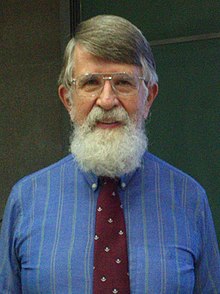Don Page (physicist)
Don Page | |
|---|---|
 Page at Department of Physics, National Taiwan University | |
| Born | December 31, 1948 Bethel, Alaska, United States |
| Nationality | Canadian |
| Known for | Page curve Page time Hawking–Page phase transition Chandrasekhar–Page equations |
| Alma mater | William Jewell College California Institute of Technology University of Cambridge |
| Scientific career | |
| Fields | Theoretical physics |
| Institutions | University of Alberta |
| Thesis | Accretion into and emission from black holes (1976) |
| Doctoral advisor | Kip Thorne Stephen W. Hawking |
| Website | www |
Don Nelson Page FRSC (born December 31, 1948) is an American-born Canadian theoretical physicist at the University of Alberta, Canada.[1][2][3]
Work
Page's work focuses on quantum cosmology and theoretical gravitational physics, and he is noted for being a doctoral student of Stephen Hawking, who was at Caltech during 1974-1975, in addition to publishing several journal articles with him.[4][5] Page got his BA at William Jewell College in the United States in 1971, attaining an MS in 1972 and a PhD in 1976 at Caltech.[6]
His professional career started as a research assistant in Cambridge from 1976-1979, followed by an assistant professorship at Penn State from 1979-1983, and then an associate professor at Penn State until 1986 before taking on the title of professor in 1986. Page spent four more years at Penn State before moving to become a professor at the University of Alberta in Canada in 1990.
In 1993, he argued that if a black hole starts in a pure quantum state and evaporates completely by a unitary process, the von Neumann entropy of the Hawking radiation initially increases and then decreases back to zero when the black hole has disappeared.[7] This is known as the Page curve, and the turnover point of the curve the Page time.[8][9] For many researchers, deriving the Page curve is synonymous with solving the famous black hole information paradox.[10]: 291
Awards and honors
In 2012, Page became a Fellow of the Royal Society of Canada.[11]
Religious views
Page is an Evangelical Christian. In commenting on the debate between William Lane Craig and Sean Carroll in 2014, he states in a guest post on Carroll's website that: "...in view of all the evidence, including both the elegance of the laws of physics, the existence of orderly sentient experiences, and the historical evidence, I do believe that God exists and think the world is actually simpler if it contains God than it would have been without God."[12] In the same post he criticises William Lane Craig's Kalam Cosmological Argument, saying that it "is highly dubious metaphysically, depending on contingent intuitions [i.e. the first premise] we have developed from living in a universe with relatively simple laws of physics and with a strong thermodynamic arrow of time."
See also
References
- ^ "Don Page - University of Alberta". Archived from the original on 2013-09-27. Retrieved 2013-09-23.
- ^ "Achieve Magazine". Archived from the original on 2015-02-13. Retrieved 2015-02-12.
- ^ John Simon Guggenheim Memorial Foundation (Jun 24, 1986). "Reports ... John Simon Guggenheim Memorial Foundation". John Simon Guggenheim Memorial Foundation. Retrieved Jun 24, 2020 – via Google Books.
- ^ Stephen Hawking; Don Page (1 October 1990). "Spectrum of wormholes". Physical Review D. 42 (8): 2655–2663. Bibcode:1990PhRvD..42.2655H. doi:10.1103/PHYSREVD.42.2655. ISSN 1550-7998. PMID 10013135. Wikidata Q59348104.
- ^ S. W. Hawking; Don N. Page (December 1983). "Thermodynamics of black holes in anti-de Sitter space". Communications in Mathematical Physics. 87 (4): 577–588. doi:10.1007/BF01208266. ISSN 0010-3616. Wikidata Q59348141.
- ^ Page, Don Nelson (1976). Accretion into and emission from black holes (Ph.D.). California Institute of Technology. OCLC 945995991.
- ^ Page, Don N. (6 December 1993). "Information in Black Hole Radiation". Physical Review Letters. 71 (23): 3743–3746. arXiv:hep-th/9306083. Bibcode:1993PhRvL..71.3743P. doi:10.1103/PhysRevLett.71.3743. PMID 10055062. S2CID 9363821.
- ^ Almheiri, Ahmed; Hartman, Thomas; Maldacena, Juan; Shaghoulian, Edgar; Tajdini, Amirhossein (21 July 2021). "The entropy of Hawking radiation". Reviews of Modern Physics. 93 (3): 035002. arXiv:2006.06872. Bibcode:2021RvMP...93c5002A. doi:10.1103/RevModPhys.93.035002. S2CID 219635921.
Glossary. Page curve: Consider a spacetime with a black hole formed by the collapse of a pure state. Surround the black hole by an imaginary sphere whose radius is a few Schwarzschild radii. The Page curve is a plot of the fine-grained entropy outside of this imaginary sphere, where we subtract the contribution of the vacuum. Since the black hole Hawking radiates and the Hawking quanta enter this faraway region, this computes the fine-grained entropy of Hawking radiation as a function of time. Notice that the regions inside and outside the imaginary sphere are open systems. The curve begins at zero when no Hawking quanta have entered the exterior region, and ends at zero when the black hole has completely evaporated and all of the Hawking quanta are in the exterior region. The "Page time" corresponds to the turnover point of the curve.
- ^ Cox, Brian; Forshaw, Jeff (2022). Black Holes: the key to understanding the Universe. New York, NY: HarperCollins Publishers. p. 220-225. ISBN 9780062936691.
- ^ Grumiller, Daniel; Sheikh-Jabbari, Mohammad Mehdi (2022). Black Hole Physics: From Collapse to Evaporation. Switzerland: Springer Graduate Texts in Physics. doi:10.1007/978-3-031-10343-8. ISBN 978-3-031-10342-1. S2CID 253372811.
- ^ "Physicist Don Page named to the Royal Society of Canada". University of Alberta. January 20, 2012. Archived from the original on November 26, 2018. Retrieved March 24, 2018.
- ^ "Guest Post: Don Page on God and Cosmology". March 20, 2015. Retrieved August 28, 2019.
External links
